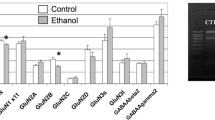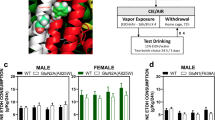Summary
The function of the N-methyl-D-aspartate (NMDA) subtype of glutamate receptor is very sensitive to acute inhibition by ethanol. Because of the role of this receptor in processes such as synaptic plasticity and neuronal development, it may contribute to the acute cognitive deficits caused by ethanol, or to the deleterious effects of ethanol during gestation. Excessive stimulation of the NMDA receptor is believed to be involved in the generation of epileptiform seizure activity as well as in excitotoxic cell death. Our studies have demonstrated that there is an adaptive “up-regulation” of NMDA receptor function in brains of chronically ethanol-treated animals and in cultured cells that have been exposed chronically to ethanol. This up-regulation appears to contribute to ethanol withdrawal seizure activity, since withdrawal seizures can be attenuated by specific NMDA receptor antagonists, and the time course of the change in receptor number parallels the time course of withdrawal seizures. In addition, cells exposed chronically to ethanol are significantly more susceptible to glutamate-induced cell death, which is mediated by the NMDA receptor, indicating a key role of the NMDA receptor in the well-characterized neuronal damage that is observed after chronic ethanol exposure and withdrawal in animals and humans. Understanding the basis for withdrawal seizures and withdrawal-induced neurotoxicity provides for the development of specific and selective therapeutic agents to ameliorate these consequences of chronic ethanol exposure and withdrawal.
Access this chapter
Tax calculation will be finalised at checkout
Purchases are for personal use only
Preview
Unable to display preview. Download preview PDF.
Similar content being viewed by others
References
Allan, A.M. and Harris, R.A. (1987) Acute and chronic ethanol treatments alter GABA receptor-operated chloride channels. Pharmacol. Biochem. Behay.27: 665–670.
Ballenger, J.C. and Post, R.M. (1978) Kindling as a model for alcohol withdrawal syndromes. Br. J. Psych.133: 1–14.
Becker, H.C. and Hale, R.L. (1993) Repeated episodes of ethanol withdrawal potentiate the severity of subsequent withdrawal seizures: an animal model of alcohol withdrawal “kindling”. Alcoholism: Clin. Exp. Res.17: 94–98.
Chandler, L.J., Newsom, H., Sumners, C. and Crews, F.T. (1993) Chronic ethanol exposure potentiates NMDA excitotoxicity in cerebral cortical neurons. J. Neurochem.60: 1578–1581.
Charness, M.E. (1993) Brain lesions in alcoholics. Alcoholism: Clin. Erp. Res.17: 2–11.
Choi, D.W. (1992) Excitotoxic cell death. J. Neurobiol.23: 1261–1276.
Clarren, S.K. and Smith, D.W. (1978) The fetal alcohol syndrome. N. Engl. J. Med.298: 1063–1067.
Collingridge, G.L. and Lester, R.A.J. (1989) Excitatory amino acid receptors in the vertebrate central nervous system. Pharmacol. Rev.40: 143–210.
Cotman, C.W., Bridges, R.J., Taube, J.S., Clark, A.S., Geddes, J.W. and Monaghan, D.T. (1989) The role of the NMDA receptor in central nervous system plasticity and pathology. J. NIH Res.1: 65–74.
Davidson, M.D., Wilce, P. and Shanley, B.C. (1993) Increased sensitivity of the hippocampus in ethanol-dependent rats to toxic effect of N-methyl-D-aspartic acid in vivo. Brain Res. 606: 5–9.
Dildy-Mayfield, J.E. and Harris, R.A. (1992a) Comparison of ethanol sensitivity of rat brain kainate, DL-a-amino-3-hydroxy-5-methyl-4-isoxaloneproprionic acid and N-methyl-Daspartate receptors expressed in Xenopusoocytes. J. Pharmacol. Exp. Ther.262: 487–494.
Dolin, S., Hudspith, M., Pagonis, C., Little, H. and Littleton, J. (1987) Increased dihydropyridine-sensitive Ca channels in rat brain may underlie ethanol physical dependence. Neuropharmacol. 26: 275–279.
Goldstein, A. and Goldstein, D.B. (1968) Enzyme expansion theory of drug tolerance and physical dependence. Res. Pub.- Assoc. Res. Nerv. Mental Disease46: 265–267.
Grant, K.A., Snell, L.D., Rogawski, M.I., Thurkauf, A. and Tabakoff, B. (1992) Comparison of the effects of the uncompetitive N-methyl-D-aspartate antagonist (±)-5-aminocarbonyl10,11-dihydro-5H-dibenzo[a,d]cyclohepten-5,10-imine (ADCI) with its structural analogs dizocilpine (MK-801) and carbamazepine on ethanol withdrawal seizures. J. Pharmacol. Exp. Ther.260: 1017–1022.
Hoffman, P.L. (1994) The effects of alcohol on excitatory amino acid receptor function. In: Kranzier, H. (ed): Handbook of Experimental Pharmacology: The Pharmacology of Alcohol Abuse. Springer-Verlag, Berlin, in apress.
Hunt, W.A. (1985) Alcohol and biological membranes. The Guilford Press, New York.
Iorio, K.R., Reinlib, L., Tabakoff, B. and Hoffman, P.L. (1992) Chronic exposure of cerebellar granule cells to ethanol results in increased NMDA receptor function. Mol. Pharmacol.41: 1142–1148.
Iorio, K.R., Tabakoff, B. and Hoffman, P.L. (1993) Glutamate-induced neurotoxicity is increased in cerebellar granule cells exposed chronically to ethanol. Eur. J. Pharmacol.248: 209–212.
Kumar, K.N., Tilakaratne, N., Johnson, P.S., Allen, A.E. and Michaelis, E.K. (1991) Cloning of cDNA for the glutamate-binding subunit of an NMDA receptor complex. Nature354: 7073.
Lister, R.G., Eckardt, M.J. and Weingartner, H. (1987) Ethanol intoxication and memory. Recent developments and new directions. In: Galanter, M. (ed): Recent Developments in Alcoholism, Vol. S. Plenum Press, New York, pp. 111–126.
Litten, R.Z. and Allen, J.P. (1991) Pharmacotherapies for alcoholism: promising agents and clinical issues. Alcoholism: Clin. Exp. Res.15: 620–633.
Little, H.J., Dolin, S.J. and Halsey, M.J. (1988) Calcium channel antagonists decrease the ethanol withdrawal syndrome. Life Sci. 39: 2059–2065.
Michaelis, E.K., Michaelis, M.L. and Freed, W.K. (1978) Effects of acute and chronic ethanol intake on synaptosomal glutamate binding activity. Biochem. Pharmacol.27: 1685–1691.
Nakanishi, S. (1992) Molecular diversity of glutamate receptors and implications for brain function. Science258: 597–603.
Phillips, T.J., Feller, D.J. and Crabbe, J.C. (1989) Selected mouse lines, alcohol and behavior. Experientia45: 805–827.
Ritzmann, R.F. and Tabakoff, B. (1976) Body temperature in mice: A quantitative measure of alcohol tolerance and dependence. J. Pharmacol. Exp. Ther.199: 158–163.
Simson, P.E., Criswell, H.E. and Breese, G.R. (1993) Inhibition of NMDA-evoked electro physiological activity by ethanol in selected brain regions: evidence for ethanol-sensitive and ethanol-insensitive NMDA-evoked responses. Brain Res. 607: 9–16.
Snell, L.D., Tabakoff, B. and Hoffman, P.L. (1993) Radioligand binding to the N-methyl-Daspartate receptor/ionophore complex: alterations by ethanol in vitroand by chronic in vivoethanol ingestion. Brain Res. 602: 91–98.
Snell, L.D., Tabakoff, B. and Hoffman, P.L. (1994a) Involvement of protein kinase C in ethanol-induced inhibition of NMDA receptor function in cerebellar granule cells. Alcoholism: Clin. Exp. Res., in press.
Snell, L.D., Iorio, K.R., Tabakoff, B. and Hoffman, P.L. (1994b) Protein kinase C activation attenuates N-methyl-D-aspartate induced increases in intracellular calcium in cerebellar granule cells. J. Neurochem., in press.
Tabakoff, B. and Hoffman, P.L. (1987) Biochemical pharmacology of alcohol. In: Meltzer, H.Y. (ed): Psychopharmacology-The Third Generation of Progress. Raven Press, New York, pp. 1521–1526.
Tabakoff, B. and Rothstein, J.D. (1983) Biology of tolerance and dependence. In: Tabakoff, B., Sutker, P.B. and Randall, C.L. (eds): Medical and Social Aspects of Alcohol Abuse. Plenum Press, New York, pp. 187–220.
Takadera, T., Suzuki, R. and Mohri, T. (1990) Protection by ethanol of cortical neurons from N-methyl-D-aspartate-induced neurotoxicity is associated with blocking calcium influx. Brain Res. 537: 109–115.
Valverius, P., Crabbe, J.C., Hoffman, P.L. and Tabakoff, B. (1990) NMDA receptors in mice bred to be prone or resistant to ethanol withdrawal seizures. Eur. J. Pharmacol.184: 185–189.
Author information
Authors and Affiliations
Editor information
Editors and Affiliations
Rights and permissions
Copyright information
© 1994 Birkhäuser Verlag Basel/Switzerland
About this chapter
Cite this chapter
Hoffman, P.L., Tabakoff, B. (1994). The role of the NMDA receptor in ethanol withdrawal. In: Jansson, B., Jörnvall, H., Rydberg, U., Terenius, L., Vallee, B.L. (eds) Toward a Molecular Basis of Alcohol Use and Abuse. Experientia, vol 71. Birkhäuser Basel. https://doi.org/10.1007/978-3-0348-7330-7_7
Download citation
DOI: https://doi.org/10.1007/978-3-0348-7330-7_7
Publisher Name: Birkhäuser Basel
Print ISBN: 978-3-0348-7332-1
Online ISBN: 978-3-0348-7330-7
eBook Packages: Springer Book Archive




